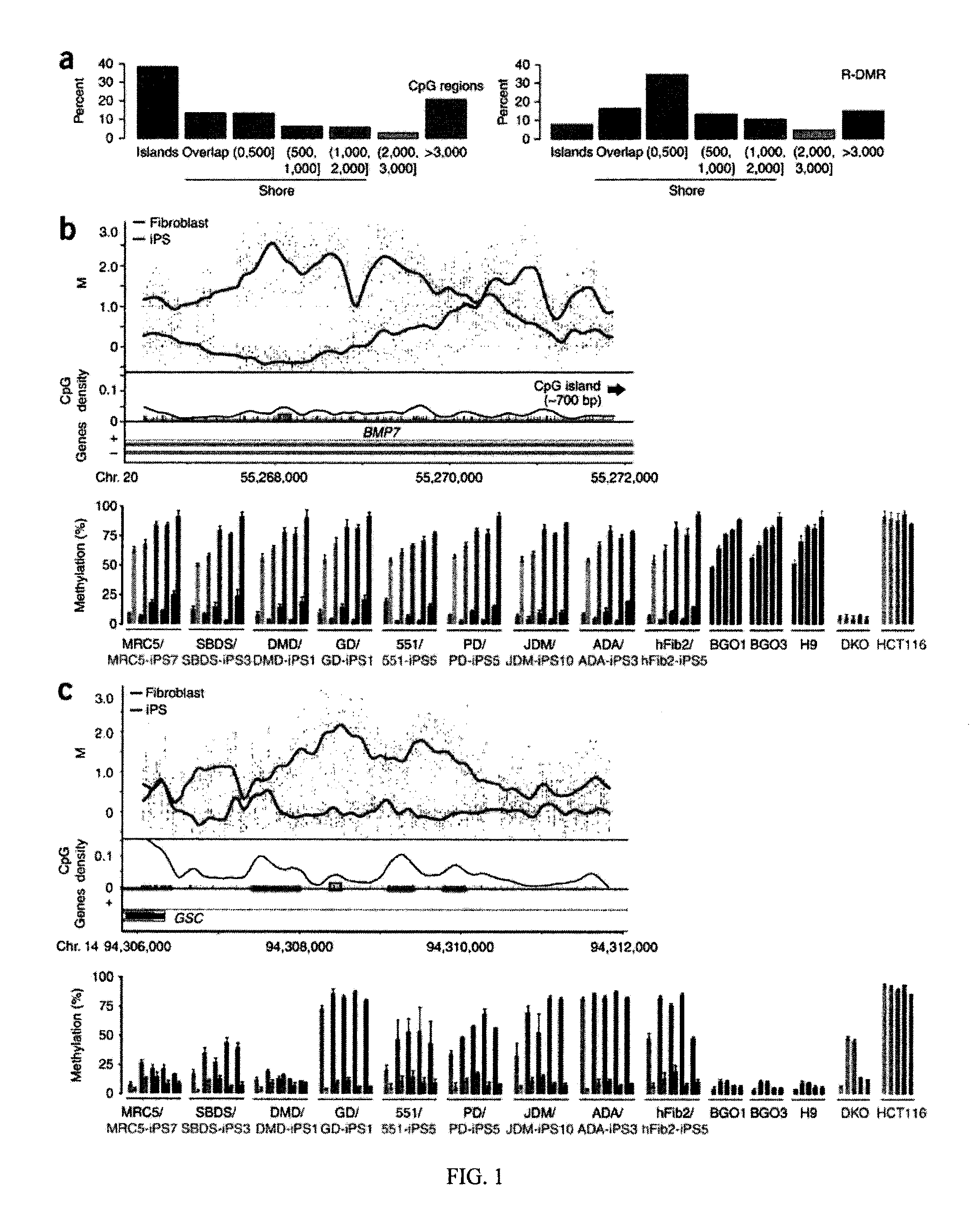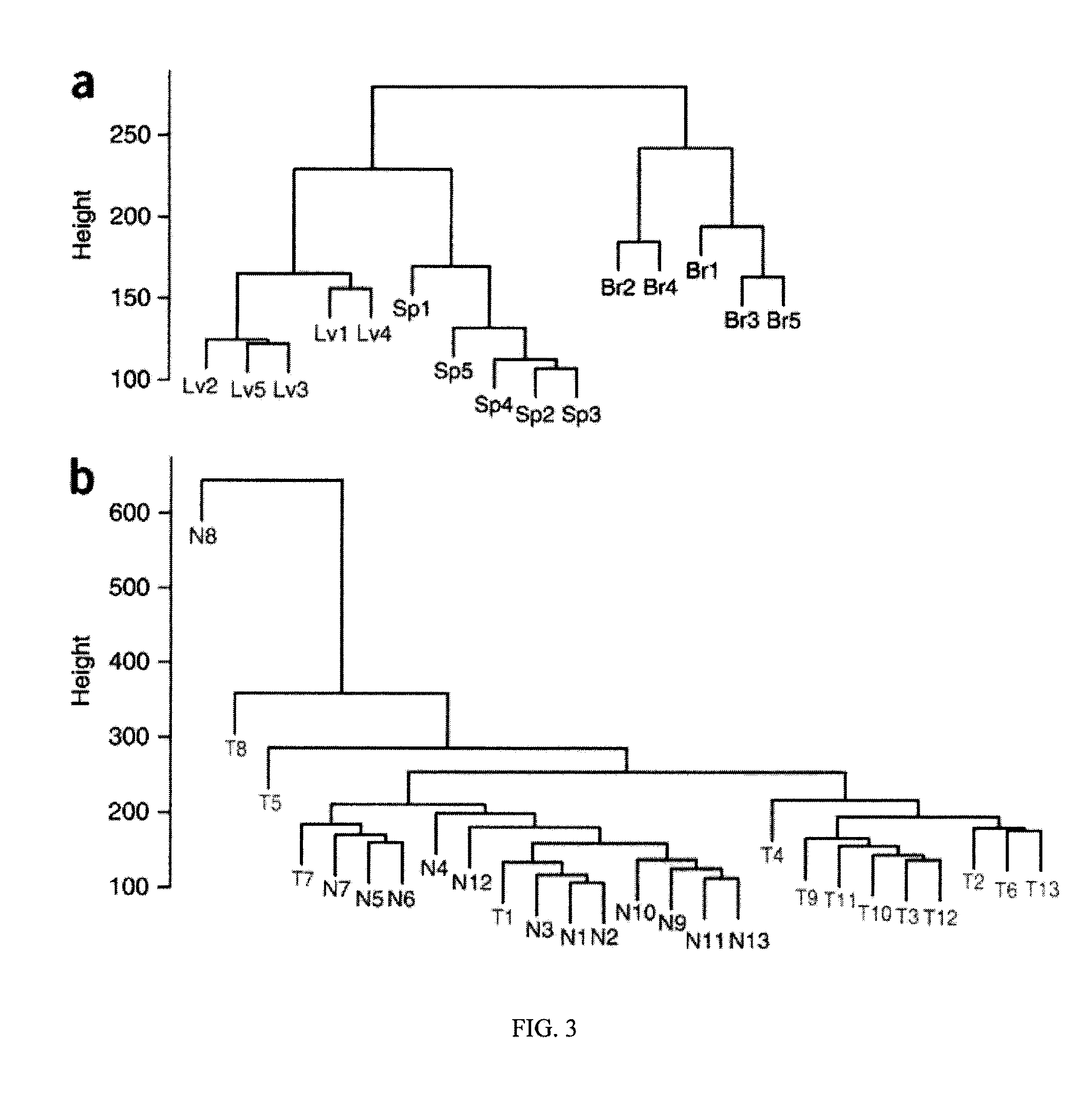Differentially methylated regions of reprogrammed induced pluripotent stem cells, method and compositions thereof
a technology of induced pluripotent stem cells and differentially methylated regions, which is applied in the direction of artificial cell constructs, biocide, and nucleotide libraries, can solve the problems of terminally differentiated blood cells that cannot reprogram efficiently as blood progenitors, reduce the epigenetic memory of ips cells, and limit the efficiency and fidelity of reprogramming. the effect of enhancing the differentiation potential of an ips cell
- Summary
- Abstract
- Description
- Claims
- Application Information
AI Technical Summary
Benefits of technology
Problems solved by technology
Method used
Image
Examples
example i
Differential Methylation of Tissue and Cancer Specific CpG Island Shores Distinguishes Human iPS Cells, ES Cells and Fibroblasts
[0117]The following experimental protocols and materials were utilized.
[0118]Summary: ES cells and iPSCs were cultured in ESC media containing 15% FBS, and 1,000 U / ml of LIF. For the reprogramming of somatic cells, retrovirus expressing Oct4, Sox2, K1f4, and Myc were introduced. For the somatic cells containing inducible reprogramming factors, the media was supplemented with 2 ng / ml of doxycycline. For DNA and RNA isolation, fESC or iPSCs were trypsinized and re-plated onto new tissue culture dishes for 45 minutes to remove feeder cells, and nucleic acids were extracted from the non-adherent cell suspension. Genomic DNA methylation analysis and pyrosequencing were performed by previously published methods.
[0119]Cell culture and isolation of RNA and genomic DNA from fibroblast, hES cells and iPS cells. iPS cell lines and their parental fibroblasts used were ...
example ii
Epigenetic Memory in Induced Pluripotent Stem Cells
[0150]The following experimental protocols and materials were utilized.
[0151]Tissue culture was performed as follows. Bl-iPSC and NP-iPSC were prepare as previously described in Hanna et al. (Cell. (133)250-264. (2008)), Kirov et al. (Genomics (82)433-440 (2003)) and Markoulaki et al. (Nat Biotechnol. (27)169-171. (2009)). The cells were cultured in standard ES maintenance media.
[0152]Generation of B-iPSC and F-iPSC was performed as follows. B-iPSC were generated from bone marrow cells collected from one-year-old B6CBAF1 mice. Early progenitor cells (lin−, CD45+, and cKit+) were sorted by FACS (HemNeoFlow Facility at the Dana Farber Cancer Institute) and stained with lineage-specific antibodies (B220; RA3-6B2, CD19; 1D3, CD3; 145-2c11, CD4; GK1.5, CD8; 536.7, Ter119; ter119, Gr-1; RB6-8C5), CD45 specific antibody (30-F11), and cKit antibody (2B8). 105 sorted cells were infected with retrovirus generated from pMXOct4, pMXSox2, pMXK1f...
PUM
| Property | Measurement | Unit |
|---|---|---|
| Digital information | aaaaa | aaaaa |
| Density | aaaaa | aaaaa |
| Distance | aaaaa | aaaaa |
Abstract
Description
Claims
Application Information
 Login to View More
Login to View More - R&D
- Intellectual Property
- Life Sciences
- Materials
- Tech Scout
- Unparalleled Data Quality
- Higher Quality Content
- 60% Fewer Hallucinations
Browse by: Latest US Patents, China's latest patents, Technical Efficacy Thesaurus, Application Domain, Technology Topic, Popular Technical Reports.
© 2025 PatSnap. All rights reserved.Legal|Privacy policy|Modern Slavery Act Transparency Statement|Sitemap|About US| Contact US: help@patsnap.com



